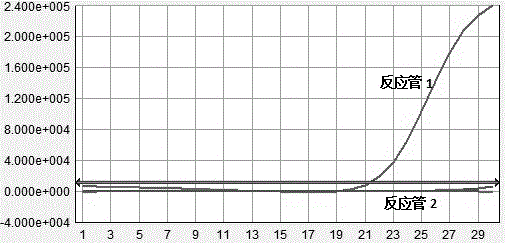Constant-temperature detection method and kit for instantly detecting listeria monocytogenes
A Listeria, detection method technology, applied in the field of constant temperature amplification technology that does not depend on high-energy energy molecules, can solve the problems of long detection time, insufficient sensitivity, and high technical requirements for detection personnel, and achieve simple composition, sensitivity and accuracy High, fast amplification and stable results
- Summary
- Abstract
- Description
- Claims
- Application Information
AI Technical Summary
Problems solved by technology
Method used
Image
Examples
Embodiment 1
[0063] Embodiment 1 (sensitivity experiment):
[0064] In this embodiment, the Listeria monocytogenes nucleic acid is diluted 10 times, 100 times, 1000 times, and 10000 times, and the diluted nucleic acid is sequentially labeled as sample 1, sample 2, sample 3, and sample 4, and the concentrations are respectively 10ng / ul, 1ng / ul, 0.1ng / ul, 0.01ng / ul, use sterilized pure water as negative control. Take five 200ul reaction tubes and mark them as reaction tubes 1~5 in turn, add 20ul reaction solution and 5ul reaction enzyme system to reaction tubes 1~5 respectively, add 2ul sample 1 to reaction tube 1, and add 2ul sample 2, and so on, add 2ul sterilized pure water to reaction tube 5, and finally make up the system to 45ul with sterilized pure water, mix well and then add 5ul starter solution respectively.
[0065]Select a constant temperature water bath to provide the constant temperature environment required for the reaction, set the temperature of the constant temperature wat...
Embodiment 2
[0067] Embodiment 2 (specificity experiment):
[0068] In this embodiment, Listeria monocytogenes nucleic acid, Salmonella nucleic acid, Escherichia coli nucleic acid, Shigella nucleic acid, and Staphylococcus aureus nucleic acid are sequentially labeled as sample 1, sample 2, sample 3, sample 4, and sample 5. The concentration is 10ng / ul. Take five 200ul reaction tubes and mark them as reaction tubes 1~5 in turn, add 20ul reaction solution and 5ul reaction enzyme system to reaction tubes 1~5 respectively, add 2ul sample 1 to reaction tube 1, and add 2ul sample 2, and so on, and finally make up the system to 45ul with sterilized pure water, mix well, and then add 5ul starter solution respectively.
[0069] Select a constant temperature water bath to provide the constant temperature environment required for the reaction, set the temperature of the constant temperature water bath to 37°C, and the reaction time to 30min.
[0070] After the reaction, 10ul products were taken fro...
Embodiment 3
[0071] Embodiment 3 (mixed infection experiment):
[0072] In this embodiment, the Salmonella-Listeria monocytogenes nucleic acid and the Escherichia coli-Listeria monocytogenes nucleic acid were labeled as sample 1 and sample 2 in sequence, and the concentrations were both 10 ng / ul. Take three 200ul reaction tubes and mark them as reaction tubes 1~3 in turn, add 20ul reaction solution and 5ul reaction enzyme system to reaction tubes 1~3 respectively, add 2ul sample 1 to reaction tube 1, and add Add 2ul of sterilized pure water to 2ul of sample 2 and reaction tube 3, and finally make up the system to 45ul with sterilized pure water, mix well and then add 5ul of starter solution respectively.
[0073] Select a constant temperature water bath to provide the constant temperature environment required for the reaction, set the temperature of the constant temperature water bath to 37°C, and the reaction time to 30min.
[0074] After the reaction, 10ul products were taken from react...
PUM
 Login to View More
Login to View More Abstract
Description
Claims
Application Information
 Login to View More
Login to View More - R&D
- Intellectual Property
- Life Sciences
- Materials
- Tech Scout
- Unparalleled Data Quality
- Higher Quality Content
- 60% Fewer Hallucinations
Browse by: Latest US Patents, China's latest patents, Technical Efficacy Thesaurus, Application Domain, Technology Topic, Popular Technical Reports.
© 2025 PatSnap. All rights reserved.Legal|Privacy policy|Modern Slavery Act Transparency Statement|Sitemap|About US| Contact US: help@patsnap.com



